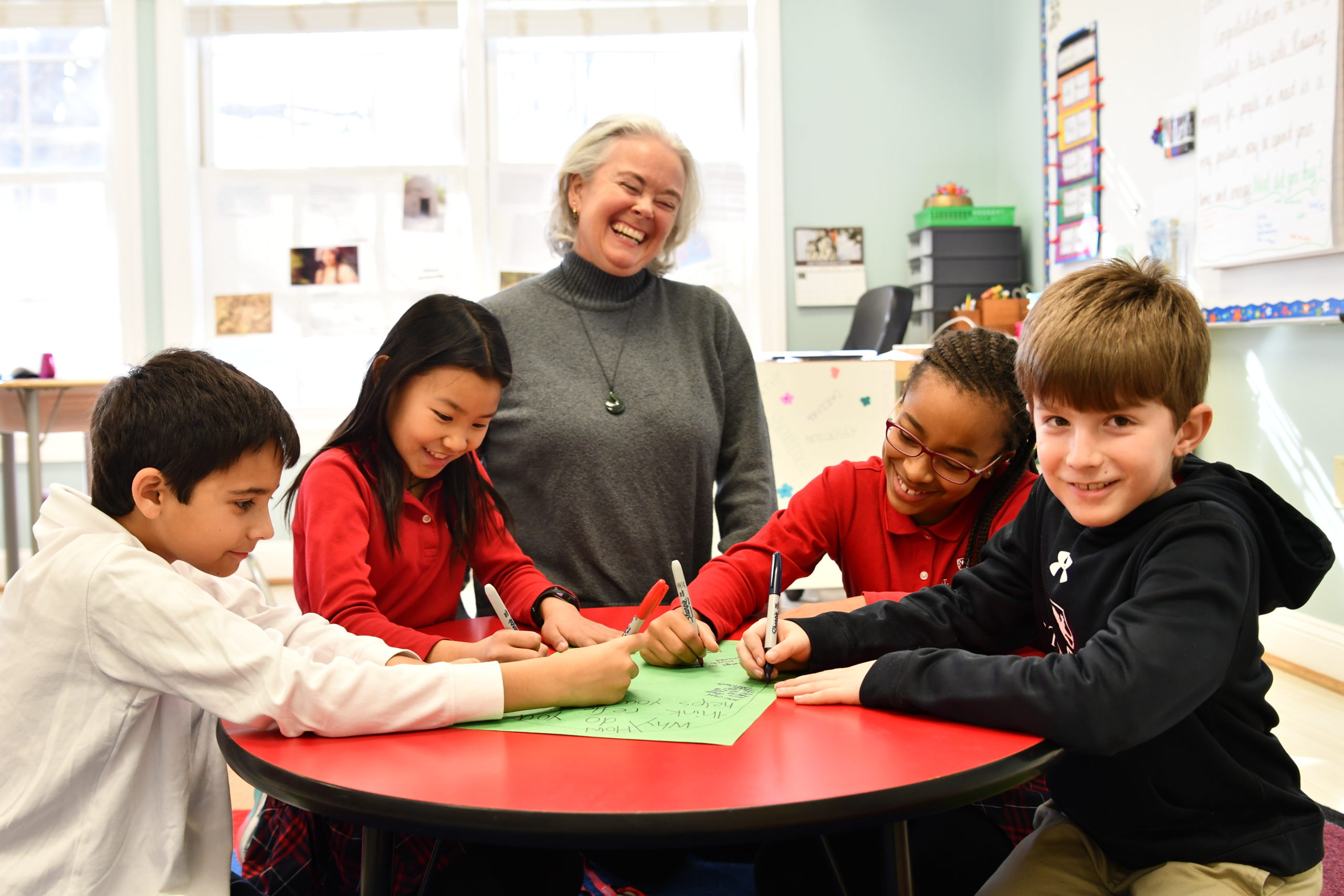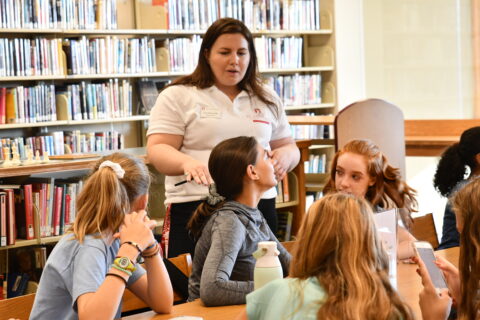By Christine Lewis
Editor’s Note: This article was originally published in Volume 1 of “Think Differently and Deeply” (2013).
Feeling valued socially. Feeling emotionally connected. A student who experiences both those feelings is better able to use his or her whole mind to maximize learning potential. That raises one very important question:
How does your child’s school care for his or her social and emotional needs?
The Responsive Classroom ® approach to teaching and learning is used at St. Andrew’s from preschool through sixth grade, and it has transformed how students feel about themselves as individuals and as members of our community.
Several years ago, a father of one of my students made it clear to me that the only thing he cared about was his child’s academic standing. He put no stock in whether his child had any friends or could function as a contributing member of the class. At the time, I had only recently been introduced to the Responsive Classroom approach (1) and while I believed on an intuitive level that academic and social success are interconnected, I was not able to articulate the research that supported the important role social and emotional skills played in the ongoing academic success of a developing child. (2) What I would have directed this parent to is the Responsive Classroom Efficacy Study that shows when the Responsive Classroom is “faithfully implemented, the approach correlated with a substantial rise – a roughly 20-point gain on average – on state standardized test scores in reading and math.” (3)
Many years later, I often think of that conversation and wish that I could have the opportunity to share with that father the clarity I have obtained, through experience and study, in this important area of teaching and learning.
Responsive teaching practices are built on the fundamental belief that along with a child’s need for shelter, food, sleep, and familial love, each growing person is also driven by the need to belong, to feel that their presence is important, and to participate in playful, engaging experiences. (4) Responsive teachers also believe that social skills are like any of the other content areas, such as reading, math, and the arts, and as such, need to be explicitly taught, learned and practiced for children to reach their full potential.
Walking into a responsive classroom on any given day, you will see the direct effect of these central principles in a myriad of ways. From the teacher’s choice of words, to active modeling of expectations, to collaborative grouping, to options for academic choice, and the obviously student-owned approach to classroom rules of conduct. (5)
Responsive teachers begin each day with a community meeting with the intention of developing a strong sense of belonging and significance. This is accomplished by ensuring that every student’s voice is heard and honored within the first few moments of each school day through opportunities to share his or her ideas and experiences with their learning community.
Perhaps one of the most tangible outcomes from this approach came during the 2011-2012 school year when our fourth-grade class had a difficult mid-year change; twins who had both been key members of our classroom community were moving away. You might be asking, “How would such a move impact the learning environment for the students who remained in the class?”
Using the routine of sharing in our morning meeting, children talked about their wishes for the twins in such a way that both the twins and their classmates felt better about the change. The structure of sharing allowed children to find connections with others while sharing things that concerned them. This is not something that fourth graders would typically feel comfortable doing!
Another central purpose of our social and emotional curriculum is the creation of self-regulation in children. Establishing a democratic classroom that addresses the developmental social and emotional needs of our students is fundamental to the Responsive Classroom CARES approach. Cooperation, Assertion, Responsibility, Empathy, and Self Regulation are the core qualities that we actively seek to nurture within our students every day of school. It is truly inspiring to observe our children offer an authentic apology of action in a clear, calm, and empathetic manner after having discussed the impact of hurtful actions and brainstormed ways we can fix someone’s hurt feelings. These human skills may seem far removed from the execution of algebra; however, in order to achieve the complicated abstract mental processes necessary for success in math, or indeed any academic discipline, a growing child requires healthy social connection, a belief that their presence matters, and confidence in their own ability to manage the emotional ups and downs that we all experience when exploring new territory. (6)
Reflection is also a key element in a responsive classroom; the end of each day is celebrated with a short community gathering where we actively think back over our day together. These moments of acknowledgement have a profoundly positive influence to support our children in their efforts to understand their own strengths and challenges as learners. It also serves to reinforce strategies for regulating their own behavioral responses. A favorite of mine is the “Compliment Circle,” (7) where students randomly take a card saying “You helped someone today” or “You took a learning risk today” and choose someone within their class to give it to. I saw the power of this activity in the life of a child who worked daily on impulse control challenges when a classmate gave him a card that said “You showed kindness today.” The child receiving the card was so taken aback by a classmate noticing his kind act that he began to view himself differently and found new motivation to redirect his energy in positive ways. The results were not short-lived but continued to fuel his efforts toward self-control throughout the year. This is valuable work not only for the well-being of our students, but also because we know that the ability to exercise self-control is a strong predictor of academic success. (8)
The Responsive Classroom approach reaches far beyond the old perception of social and emotional curriculums producing “nice” kids in a warm and fuzzy environment. It allows us to build intelligent guidelines for school and to develop classroom practices that are informed by current neuroscience (9) and are relevant to the children of the 21st Century.
The teachers and administration at St. Andrew’s understand the importance of social cognition as integral to the process of learning for every child. The commitment to this truth has enriched the relationships within the faculty, powered the direction of administrative decisions, and led to happy, self-directing children, who relish their academic successes and believe in their ability to overcome their academic challenges.
Citations
- S. Rimm-Kaufman and B. Sawyer, “Efficacy of the Responsive Classroom Approach: Results from a Three Year, Longitudinal Randomized Control Trial” (2012) https://www.sree.org/conferences/2012f/program/downloads/abstracts/683.pdf
- S. Hinshaw, “Externalizing Behavior Problems and Academic Underachievement in Childhood and Adolescence: Causal Relationships and Underlying Mechanisms” Psychological Bulletin 111 (1992): 127–155.
- Sara Mosle, “Teaching Lessons,” The New York Times Week in Review (October 28, 2012) 10.
- R. Kriete, The Morning Meeting Book (Greenfield, MA: Northeast Foundation for Children, 2002) 9.
- R. Charney, Teaching Children to Care (Massachusetts: Northeast Foundation for Children, 2002) 17-36.
- P. Graviano et al., “The Role of Emotion Regulation and Children’s Early Academic Success,” Journal of School Psychology 45 (2007): 3–19.
- D. Januszka, and K. Vincent, Closing Circles: 50 Activities for Ending the Day in a Positive Way (Massachusetts: Northeast Foundation for Children, 2012) 40.
- Y. Shoda, W. Mischel, & P.K. Peake, “Predicting Adolescent Cognitive and Self-Regulatory Competencies from Preschool Delay of Gratification: Identifying Diagnostic Conditions,” Developmental Psychology 26 (1990): 26, 978–986.
- D. Walsh, The Brain Goes to School. Educating the Whole Child: Learning and the Brain Society Conference (March 2012). http://www.DrDaveWalsh.com




